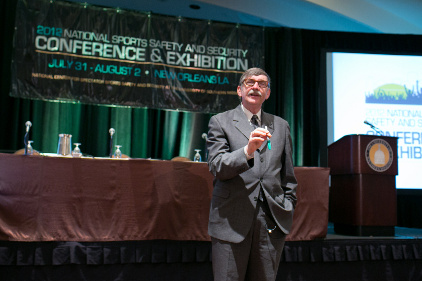
|
| Gordon Graham delivers his keynote speech at the NCS4 Conference on August 2, 2012. Photo: Chris Williams/Chris Pike/Zoeica Images New Orleans |
How do you determine the level of risk associated with a particular task?
According to Gordon Graham of Graham Research Consultants, you check the box.
Check out the grid here:
| High Risk | High Risk, High Frequency | High Risk, Low Frequency |
| Low Risk | Low Risk, High Frequency | Low Risk, Low Frequency |
| High Frequency | Low Frequency |
Now, Graham says, while error and risk appear in every section of the box, problems most rarely occur in high-frequency tasks.Each task can be assigned to a different box – high-frequency, low-risk; high-frequency, high-risk; low-frequency, low-risk; and low-frequency, high-risk.
“Everything you do goes into one of these four boxes,” Graham says during his keynote lecture at the National Center for Spectator Sport Safety and Security Conference 2012. “Personally and professionally – where are errors most likely to occur? Rarely do we make mistakes on high-frequency events. Things we do a lot, we tend to do very well.
“You give me a good employee in any occupation, in any profession – this is a universal concept – you give me a good woman or man, and put that person in a high-frequency task, you get a phenomenon called RPDM: Recognition Prime Decision-Making,” he says. “The theory is: the brain is an accumulation of past experiences. When the brain gets involved in a task, it scans the hard-drive, looks for memory markers.
“That employee thinks: ‘Have I ever done this task before? A bunch of times. Did it end up going right? Every time. So why don’t I just do it the same way I did it last time, I bet it goes right. If it goes right I stay out of trouble.’
“That whole process is known as RPDM,” Graham says.
Low-frequency events are the main problem, he says. And low-frequency, low-risk events aren’t particularly worrisome either – even if they go wrong, he says, the consequences are minimal.
“High-risk, low-frequency events worry me in every occupation,” Graham says. “Things that are very risky and done very rarely, the employee does not have the memory markers to deal with these. This is a universal concept.”
“Every time you give your people a new piece of equipment: a new toy, a new tool, a new vehicle, for a while they’re playing in the top right box – high-risk, low-frequency,” he says.
Graham continues to note that there are two kinds of high-risk, low-frequency events:
- Discretionary Timed Tasks
- Core Critical Tasks
In timed tasks, employees have time to think about what they’re going to do, and Graham recommends taking every bit of that time to consider the best course of action (“If you have a minute, take 59 seconds!” he says).
For core critical tasks, the most risky, Graham says, there is no time to think, but these happen rarely.
In these tasks, he recommends ensuring that employees are able to rely on memory markers formed from consistent and continuous training, forming what is essentially a taught reflex.
“Every day you need to train,” he says. “You start studying tragedies and tragedies that were averted – training.
“What about Sully Sullenberger” – the pilot who crash-landed his plane in the Hudson River in 2009 – “have you read his book?” Graham asks. “He says that every day he made a small deposit of training or experience in his memory bank, knowing full well that someday he would have to make a massive instant withdrawal. That was a core critical task, and he pulled it off.”
“Every day you’ve got to train,” he says. “That’s how you mobilize a program.”
